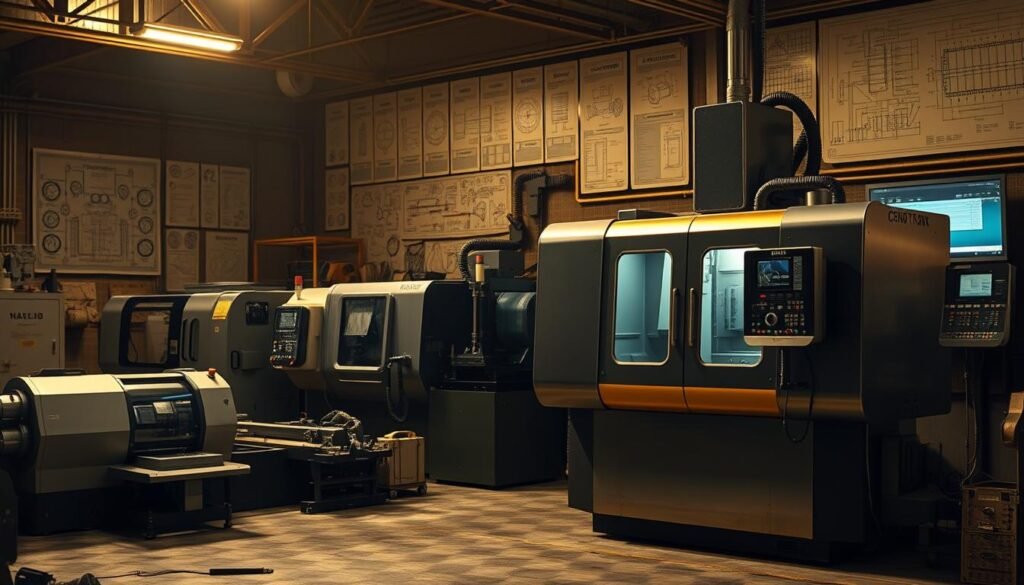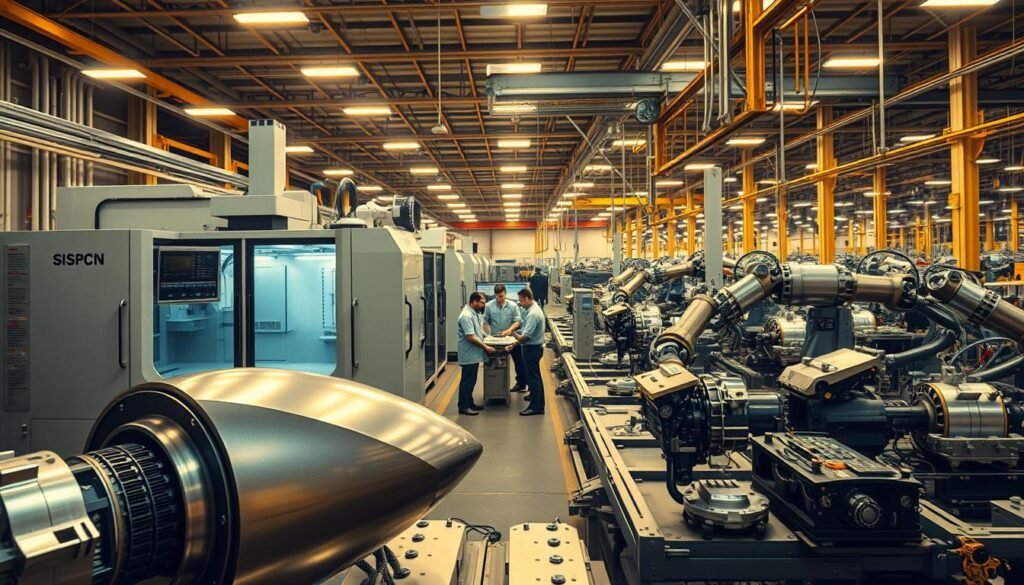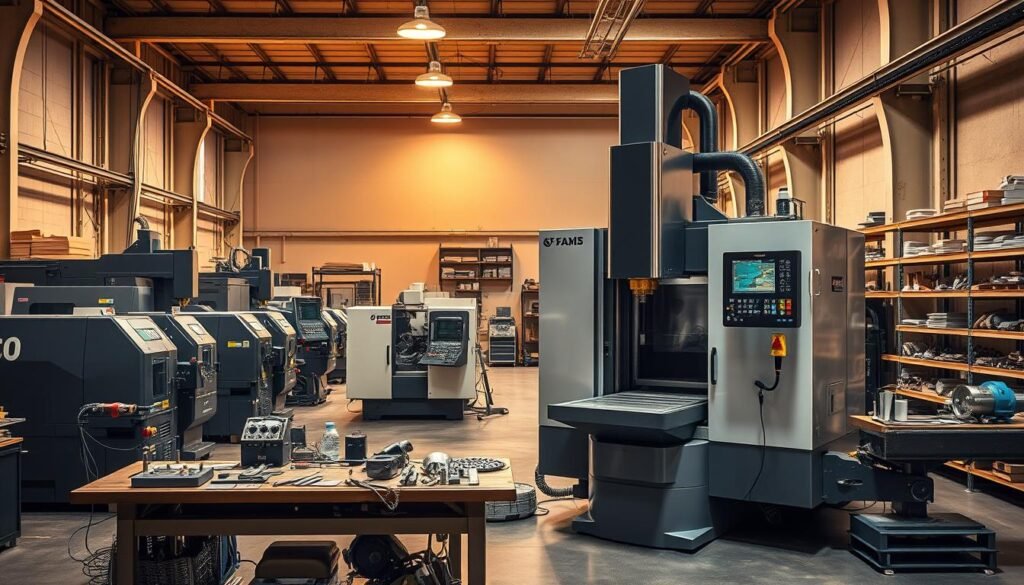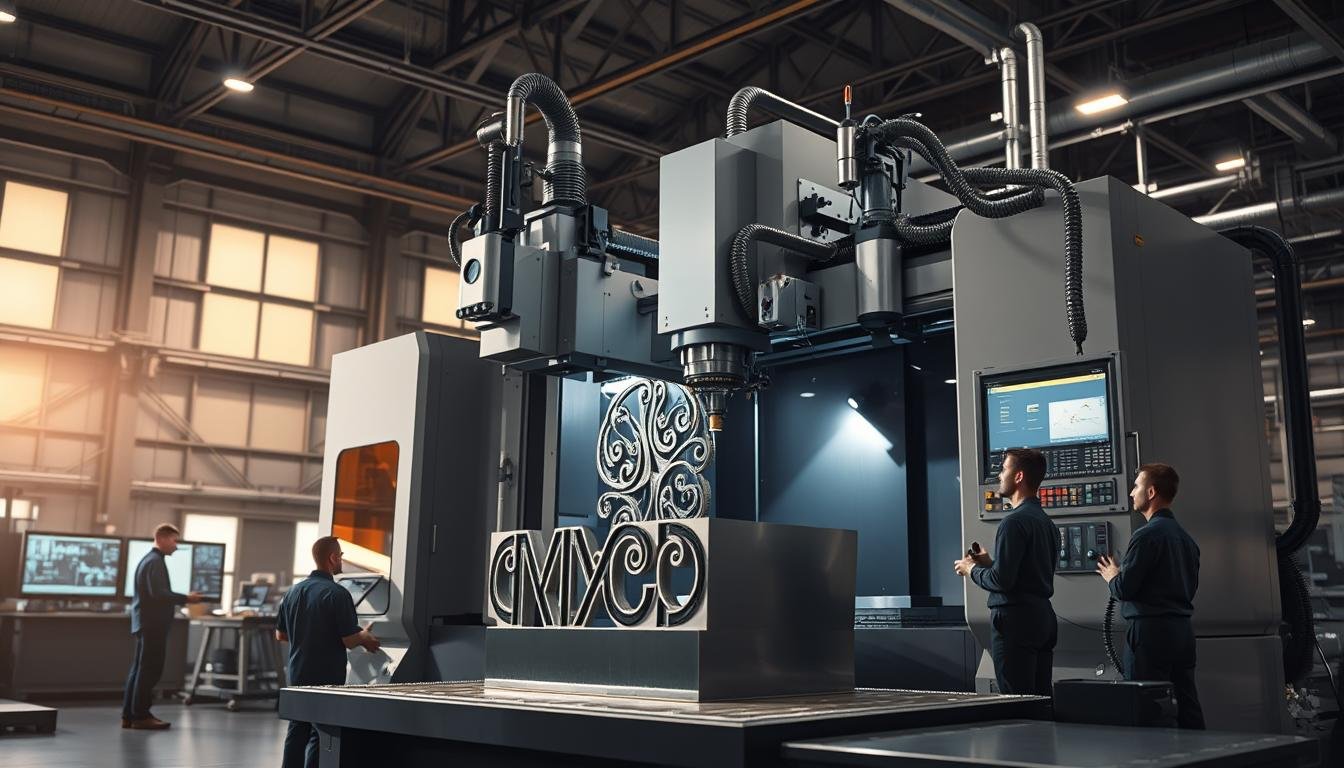Multi-axis CNC machining is a big step forward in CNC tech. It makes complex, high-quality parts for many industries. Unlike old 3-axis methods, it moves on many axes at once. This makes detailed shapes more accurately.
In today’s fast-paced world, knowing about multi-axis CNC is key. It helps companies work faster, cut down on wait times, and keep up with new tech. At Mekalite, we focus on top-notch machining solutions for our partners. We use the latest tech to make sure our CNC work is precise and excellent.
Key Takeaways
- Multi-axis CNC machining enhances design complexity and precision.
- It offers significant reductions in machining time compared to traditional methods.
- Advanced manufacturing technologies improve efficiency and quality.
- Increased flexibility allows for better adaptation to evolving industry demands.
- With precision machining, companies can achieve tighter tolerances and superior finish.
- Utilizing expert CNC machining services enhances overall production capabilities.
Understanding CNC Machining
CNC machining is key in today’s manufacturing. It uses computers to control tools for precise work. This method makes parts from metals and plastics with great accuracy.
Definition of CNC Machining
CNC machining means using computers to run machines. It does tasks like milling and drilling with high precision. First, we make a design on a computer, then turn it into a program for the CNC machine.
Process Overview
We start by designing the part. Then, we turn the design into a program for the CNC machine. This ensures the part is made accurately and consistently.
CNC machining is great for making lots of parts. It works with many materials, like aluminum and steel. It’s also good for making complex parts that customers need.
For more on multi-axis CNC machining and precision CNC machining services, check out these links.
The Evolution of CNC Equipment

The journey of CNC equipment evolution has changed manufacturing a lot. Each step brought new abilities, making machining better. We’ll look at three key steps in CNC technology, showing how it went from simple to precise.
Phase 1: The Turn-Mill
The start of turn-mill technology was a big change in CNC machining. It allowed for turning and milling at the same time. This made production faster and more efficient by needing fewer machines.
Phase 2: Enter Multitasking Machines
Then came multitasking machines, bringing more power and flexibility. These machines could do complex milling while turning. They met the need for detailed and strong parts in many fields.
Phase 3: Advancements in 5-Axis Milling
The latest step is in 5-axis machining. Now, machines can work on five sides of a piece at once. This makes making complex parts easier and more precise. It’s key for making advanced parts today.
What Is Multi-Axis CNC Machining

Multi-axis CNC machining is a high-tech way to make things. It uses many axes to make parts with complex shapes. This method is key for making detailed parts, which is why it’s popular today.
Definition and Explanation
This method works in three dimensions. It uses 3-axis, 4-axis, and 5-axis machining. Each type has its own benefits. This means parts can be drilled, milled, and turned without moving them by hand.
Types of Multi-Axis Machining
- 3-axis machining: The basic type, where the tool moves in X, Y, and Z directions.
- 4-axis machining: Adds a new dimension by rotating around one axis, making designs more complex.
- 5-axis machining: The most versatile, allowing movement in five axes for the highest precision.
Comparison to Traditional CNC Machining
Old 3-axis machining needs many setups for simple tasks. This takes more time and can lead to mistakes. But, multi-axis machining does things in fewer steps. It makes the process faster and more accurate.
| Machining Type | Axes Involved | Typical Applications | Advantages |
|---|---|---|---|
| 3-axis machining | X, Y, Z | Basic parts production | Simple, cost-effective operations |
| 4-axis machining | X, Y, Z, A (rotation) | Complex geometries | Reduced setup time, better surface finish |
| 5-axis machining | X, Y, Z, A, B (dual rotations) | Intricate designs | High precision, minimal repositioning |
Benefits of Multi-Axis CNC Machining
Multi-axis CNC machining brings many benefits to different industries. It helps companies work better and faster. This is key for making precise parts.
Increased Precision and Complexity
Multi-axis CNC machining can work on many planes. This lets makers create very detailed designs and parts. It’s great for things like aerospace and medical devices.
This high precision means products work well. They are reliable.
Reduction in Machining Time
Another big plus is how it cuts down machining time. Making complex parts needs fewer setups. This makes work flow better.
Being faster means getting products to market quicker. This gives companies an edge in today’s fast world.
Cost-Effective Manufacturing
It also makes making things cheaper. By being more precise, companies use less material and waste less. This saves money.
It’s important for keeping costs down while still making quality products.
| Benefit | Description |
|---|---|
| Increased Precision | Enables the creation of complex parts that meet strict specifications. |
| Reduced Machining Time | Less setup required, enhancing overall productivity and efficiency. |
| Cost-Effective Manufacturing | Minimizes errors and waste, leading to lower production costs. |
Applications Across Industries

Multi-axis CNC machining has changed many important fields. It meets special needs and rules in three big areas: aerospace, medical devices, and cars. This tech shows how versatile and precise it is in each field.
Aerospace Industry Requirements
The aerospace world needs parts that are very high quality and safe. Multi-axis CNC machining makes complex turbine blades and key parts with great precision. This makes sure these parts work well and save fuel.
Medical Device Manufacturing
In medical devices, being precise and clean is key. Tools and implants need to be very accurate and made in a clean way. Multi-axis machining helps by making detailed shapes and keeping quality high for medical use.
Automotive Component Production
The car world uses multi-axis CNC machining for detailed engine parts. This tech makes cars run better and more efficiently. It also makes making parts faster and more reliable.
| Industry | Key Requirements | Multi-Axis Machining Benefits |
|---|---|---|
| Aerospace | High precision, strict safety regulations | Complex parts with tight tolerances |
| Medical Devices | Precision, cleanliness, robustness | Intricate designs for safety and performance |
| Automotive | Efficiency, performance, and reliability | Improved manufacturing speed and accuracy |
Factors to Consider Before Adopting Multi-Axis CNC Machining

Choosing multi-axis CNC machining is a big step. It requires looking at several important factors. You need to pick the right machines, check out CAM software, and train your team well.
Choosing the Right Equipment
It’s crucial to pick the right machines for multi-axis work. The right tools make sure everything works well together. Knowing what your machines can do helps get the best results and work faster.
Evaluating Your CAM Software
A good computer-aided manufacturing system is vital for moving to multi-axis. You should check your CAM software to see if it can handle complex tasks. This helps find out if you need to update or change anything for smooth work.
Training and Skill Development Needs
Training your CNC operators is key to using new multi-axis tech well. Investing in training helps improve skills, making work better and faster. It’s important to keep learning to stay ahead in machining.
Advanced Technologies Enhancing Multi-Axis CNC Machining
The world of multi-axis CNC machining is getting better thanks to new tech. Companies are using tools like simulation and optimization software. They also use IoT in CNC systems to get the most out of their machines.
Simulation and Optimization Software
Advanced software gives a virtual look at how machining works. It lets makers change things before they start. This way, they can avoid problems and make things better.
These tools find the best way to make things. They help make things faster and use less waste. This means better work and more done.
IoT and Real-Time Monitoring Integration
IoT makes CNC machines talk to each other in real time. This lets makers keep an eye on how things are going. They can fix problems fast and keep making things without stopping.
Real-time monitoring shows where things can get better. This lets makers make quick changes. Using this tech helps makers find even better ways to make things, like leading industry experts suggest.
Sustainability in Multi-Axis CNC Machining
Sustainability is key in the manufacturing world. Multi-axis CNC machining offers a chance to use green practices. Using eco-friendly materials, cutting down waste, and saving energy are important steps.
Utilization of Eco-Friendly Materials
Switching to eco-friendly materials is crucial for less environmental harm. Biodegradable or recycled materials help meet today’s green goals. They cut down waste and win over green-minded buyers.
Waste Reduction Strategies
Reducing waste is essential in CNC machining. Near-net-shape making and smart nesting help a lot. Designing parts better uses materials, making businesses more efficient and green.
Energy Efficiency Practices
Using less energy is vital for a smaller carbon footprint. VSD technology in CNC machines saves energy and cuts costs. As we use more energy-saving methods, making things greener becomes the norm.
Conclusion
The future of multi-axis CNC machining is changing fast. New technologies and a focus on being green are leading the way. This means we need to be very precise and use less waste and energy.
At Mekalite, we’re all about finding new ways to make things better. We want to help our partners grow and work better. We do this by using the latest tech and making things more sustainable.
We don’t just follow trends; we lead the way. We aim to be top in quality and care for the planet. By doing this now, we’re making a better future for manufacturing.
FAQ
What is multi-axis CNC machining?
Multi-axis CNC machining is a way to make parts with complex shapes. It uses many axes at once. This makes parts more precise than traditional methods.
How does CNC machining improve manufacturing efficiency?
CNC machining makes making parts faster and more precise. It cuts down on setup time and mistakes. This saves money and time, which is key in today’s fast market.
What are the main types of multi-axis machining?
There are 3-axis, 4-axis, and 5-axis machining. Each type can make more complex parts. This is important for industries like aerospace and cars.
What industries benefit from multi-axis CNC machining?
Aerospace, medical, and automotive industries gain a lot. They need precise parts for their work. Multi-axis machining helps make these parts.
What factors should companies consider before adopting multi-axis CNC machining?
Companies should think about the right equipment and software. They also need to train their workers. This ensures they use the technology well.
How do advanced technologies enhance multi-axis CNC machining?
New tech like simulation and IoT help a lot. They make the process more efficient and reduce waste. This is good for the environment and saves money.
In what ways does sustainability play a role in multi-axis CNC machining?
Sustainability comes from using green materials and reducing waste. Energy-saving tech also helps. These steps lower the environmental impact.
What is the future of multi-axis CNC machining?
The future is about being more precise, reducing waste, and saving energy. As demands change, using new tech and green practices will be key to success.


